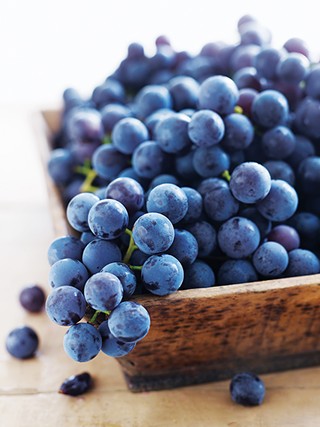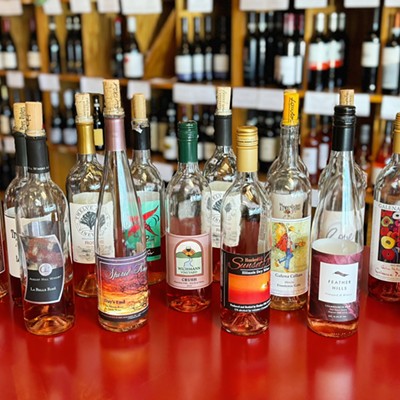Among the new crop apples and blackberries on offer at Barbara Hunt's stand at the downtown farmers market on a recent morning were three varieties of sweet plump grapes. Two are mystery varieties that have been growing on Hunt's property for decades. The third variety is fredonia, an heirloom grape variety that Hunt planted with her husband, Cloyd, on a corner of their property nearly 50 years ago. A cold-tolerant variety developed in Fredonia, New York, fredonia grapes are one of the earliest to set fruit and ripen. The flavor of fresh, fully ripened grapes like those sold by Hunt may come as a surprise to those who've never tasted them before. Firm but not crunchy like grocery store grapes, the flavors come in layers – first sweet, then tart, with a unique musky aroma and a hint of spice.
Concord grapes, with their thick deeply pigmented skin, will be ready to harvest soon. A thoroughly American variety, Concord grapes are named after the village in Massachusetts where they were bred in 1849 by Ephraim Wales Bull, who spent years breeding the indigenous grape varieties that grew wild throughout New England. Just 20 years later, his prize-winning Concord grapes would be processed into the first known shelf-stable nonalcoholic grape juice by a Dr. Thomas Welch, a dentist and Methodist minister who was looking for a less tipsy way to take communion.
Concord grapes ripen a bit later and will be available soon at the farmers market and at Suttill's Gardens in Springfield, where I've been buying them for years. A labor of love, they do have seeds that must be removed before preparing. Most jelly recipes call for boiling the grapes and sugar, then straining out the solids with a cheesecloth. Hunt, who also sells jams and fruit butters at her market stand, uses a food mill to remove the seeds and retain as much of the flavor and antioxidant-rich pulp as possible when preserving her grape harvest.
Fresh table grapes are delicious simply eaten out of hand or there are myriad ways to use them in the kitchen. Removing the seeds is simple, although tedious. My preferred method is to slice the grape in half and use my fingernail to flick out the small brown seed. This is not a fast process, but many hands (or a binge-worthy TV show) make light work. Once the seeds are removed, grapes can be used like any other berry in muffins, upside-down cakes or in this old-fashioned grape pie. They can also be used to make an Aigre-Doux, which might be the simplest way to preserve them, despite the fancy name. The French term for "sweet-sour," an aigre-doux is an incredibly versatile ingredient that can uplift a vinaigrette, pan sauce, cheeseboard or even a cocktail.
Concord Grape Pie
This pie is a regional favorite in upstate New York, where half of the nation's supply of Concord grapes are grown.
Ingredients
3 pounds Concord grapes
1 cup sugar, plus additional for sprinkling
1/2 cup cornstarch
A pinch of salt
½ recipe of pie crust, rolled into a 12-inch circle, plus extra for decoration, if desired (https://www.illinoistimes.com/springfield/easy-as-pie/Content?oid=11439241)
1 egg beaten with 1 tablespoon water or milk
Preparation
Wash, halve and pit the grapes, making sure to reserve the juice. Combine the juice in a stock pot with the sugar, cornstarch and salt and bring to a boil. Cook for two minutes, stirring continuously. Remove from the heat, stir in the seeded grapes and allow to cool completely. This mixture can be made a day ahead or even frozen for later use.
When ready to bake, preheat the oven to 425 degrees. Line a 9-inch pie plate with the pastry crust and crimp the edges. Pour the cooled filling into the prepared pie shell and arrange pastry decorations over the top as desired. Brush with the glaze and sprinkle with sugar. Place the pie in the 425-degree oven and bake for 10 minutes, then reduce the heat to 350 degrees and bake 45 minutes more, until the grape juice is thick and bubbling in the center of the pie. Allow to cool thoroughly before serving.
Grape Aigre-Doux
Adapted from a recipe in Preservation Kitchen, by Paul Virant
Ingredients
1 ½ cups off-dry white wine, preferably an aromatic variety like Riesling or Gewurztraminer
¾ cup Champagne or cider vinegar
½ cup sugar
½ teaspoon kosher salt
2 teaspoons freshly ground pepper
1 pound grapes, seeded if necessary
4 half-pint jars with new lids and bands
Preparation
Combine the wine, vinegar, sugar, salt and pepper in a saucepan and bring to a simmer over medium-high heat (you can also do this in the microwave). Pack the grapes into clean, hot jars and pour the hot wine mixture over them. Check for air pockets and wipe the rims before screwing on the lids and rings. Place the jars in a pot of simmering water fitted with a rack. When the water begins to boil, set a timer for 15 minutes. When the time is up, turn off the heat and let the jars sit in the hot water for a few minutes before removing them from the pot. Allow them to cool completely.
To use in a pan sauce, add the liquid from the jar and reduce by half. Remove the pan from the heat and swirl in pats of cold butter, one at a time, until the sauce becomes velvety, then add the grapes. Delicious over duck, turkey or salmon.


















